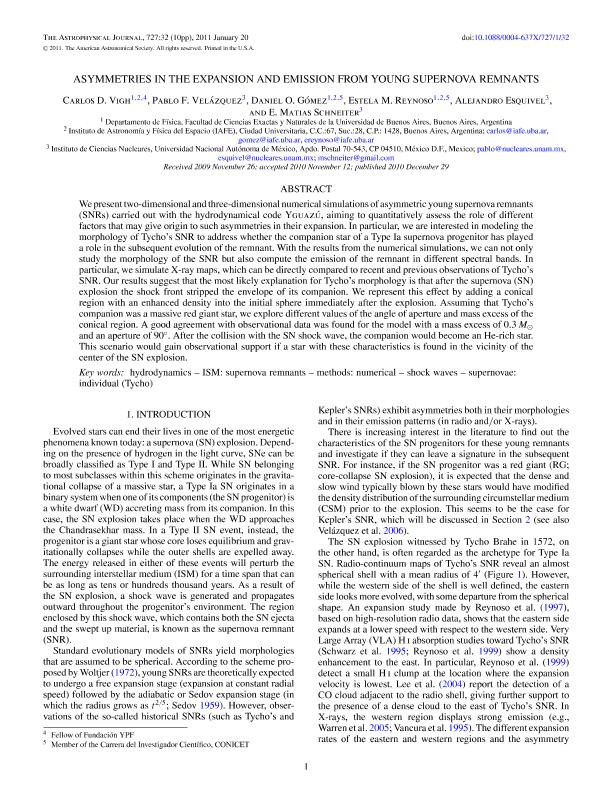Mostrar el registro sencillo del ítem
dc.contributor.author
Vigh, Carlos Donato

dc.contributor.author
Velázquez, Pablo F.
dc.contributor.author
Gomez, Daniel Osvaldo

dc.contributor.author
Reynoso, Estela Marta

dc.contributor.author
Esquivel, Alejandro
dc.contributor.author
Schneiter, Ernesto Matías

dc.date.available
2017-07-05T18:41:04Z
dc.date.issued
2011-01
dc.identifier.citation
Vigh, Carlos Donato; Velázquez, Pablo F.; Gomez, Daniel Osvaldo; Reynoso, Estela Marta; Esquivel, Alejandro; et al.; Asymmetries in the Expansion and Emission from Young Supernova Remnants; IOP Publishing; Astrophysical Journal; 727; 1; 1-2011; 32,1-10
dc.identifier.issn
0004-637X
dc.identifier.uri
http://hdl.handle.net/11336/19624
dc.description.abstract
We present two-dimensional and three-dimensional numerical simulations of asymmetric young supernova remnants (SNRs) carried out with the hydrodynamical code YGUAZÚ, aiming to quantitatively assess the role of different factors that may give origin to such asymmetries in their expansion. In particular, we are interested in modeling the morphology of Tycho's SNR to address whether the companion star of a Type Ia supernova progenitor has played a role in the subsequent evolution of the remnant. With the results from the numerical simulations, we can not only study the morphology of the SNR but also compute the emission of the remnant in different spectral bands. In particular, we simulate X-ray maps, which can be directly compared to recent and previous observations of Tycho's SNR. Our results suggest that the most likely explanation for Tycho's morphology is that after the supernova (SN) explosion the shock front stripped the envelope of its companion. We represent this effect by adding a conical region with an enhanced density into the initial sphere immediately after the explosion. Assuming that Tycho's companion was a massive red giant star, we explore different values of the angle of aperture and mass excess of the conical region. A good agreement with observational data was found for the model with a mass excess of 0.3 M ☉ and an aperture of 90°. After the collision with the SN shock wave, the companion would become an He-rich star. This scenario would gain observational support if a star with these characteristics is found in the vicinity of the center of the SN explosion.
dc.format
application/pdf
dc.language.iso
eng
dc.publisher
IOP Publishing

dc.rights
info:eu-repo/semantics/openAccess
dc.rights.uri
https://creativecommons.org/licenses/by-nc-sa/2.5/ar/
dc.subject
Supernova Remnants
dc.subject
Methods: Numerical
dc.subject
Shock Waves
dc.subject.classification
Astronomía

dc.subject.classification
Ciencias Físicas

dc.subject.classification
CIENCIAS NATURALES Y EXACTAS

dc.title
Asymmetries in the Expansion and Emission from Young Supernova Remnants
dc.type
info:eu-repo/semantics/article
dc.type
info:ar-repo/semantics/artículo
dc.type
info:eu-repo/semantics/publishedVersion
dc.date.updated
2017-07-05T18:14:43Z
dc.journal.volume
727
dc.journal.number
1
dc.journal.pagination
32,1-10
dc.journal.pais
Reino Unido

dc.journal.ciudad
Londres
dc.description.fil
Fil: Vigh, Carlos Donato. Consejo Nacional de Investigaciónes Científicas y Técnicas. Oficina de Coordinación Administrativa Ciudad Universitaria. Instituto de Astronomía y Física del Espacio. - Universidad de Buenos Aires. Facultad de Ciencias Exactas y Naturales. Instituto de Astronomía y Física del Espacio; Argentina
dc.description.fil
Fil: Velázquez, Pablo F.. Universidad Nacional Autónoma de México. Instituto de Ciencias Nucleares; México
dc.description.fil
Fil: Gomez, Daniel Osvaldo. Consejo Nacional de Investigaciónes Científicas y Técnicas. Oficina de Coordinación Administrativa Ciudad Universitaria. Instituto de Astronomía y Física del Espacio. - Universidad de Buenos Aires. Facultad de Ciencias Exactas y Naturales. Instituto de Astronomía y Física del Espacio; Argentina
dc.description.fil
Fil: Reynoso, Estela Marta. Consejo Nacional de Investigaciónes Científicas y Técnicas. Oficina de Coordinación Administrativa Ciudad Universitaria. Instituto de Astronomía y Física del Espacio. - Universidad de Buenos Aires. Facultad de Ciencias Exactas y Naturales. Instituto de Astronomía y Física del Espacio; Argentina
dc.description.fil
Fil: Esquivel, Alejandro. Universidad Nacional Autónoma de México. Instituto de Ciencias Nucleares; México
dc.description.fil
Fil: Schneiter, Ernesto Matías. Consejo Nacional de Investigaciones Científicas y Técnicas. Centro Científico Tecnológico Conicet - Córdoba. Instituto de Astronomia Teórica y Experimental. Universidad Nacional de Córdoba. Observatorio Astronómico de Córdoba. Instituto de Astronomia Teórica y Experimental; Argentina
dc.journal.title
Astrophysical Journal

dc.relation.alternativeid
info:eu-repo/semantics/altIdentifier/url/http://iopscience.iop.org/0004-637X/727/1/32/
dc.relation.alternativeid
info:eu-repo/semantics/altIdentifier/doi/http://dx.doi.org/10.1088/0004-637X/727/1/32
Archivos asociados
